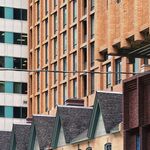Rainforest
Senior Member
It won't be overcapacity in the first year, or in the first 5 years. Probably, not in the first 10 years either. Eglinton is a popular route, but doesn't have huge trip generators or destinations.
Many of the riders will only take Eglinton to the nearest Line 1 station. Which means, all of those riders count towards the total ridership, but they do not all count as part of the peak load at the peak point. Say, if the peak load is AM rush approaching Yonge from the east, then riders who board at Weston Rd and transfer at Allen Rd do not add to that peak load. Or, vice versa.
We can't predict what happens in 20 or 30 years. If the demand for transit trips grows steadily, but the new transit construction stalls, then Eglinton might be at risk of overloading.
Many of the riders will only take Eglinton to the nearest Line 1 station. Which means, all of those riders count towards the total ridership, but they do not all count as part of the peak load at the peak point. Say, if the peak load is AM rush approaching Yonge from the east, then riders who board at Weston Rd and transfer at Allen Rd do not add to that peak load. Or, vice versa.
We can't predict what happens in 20 or 30 years. If the demand for transit trips grows steadily, but the new transit construction stalls, then Eglinton might be at risk of overloading.




